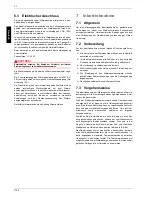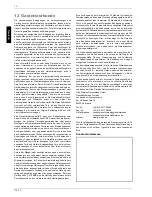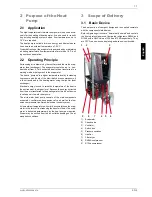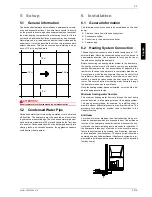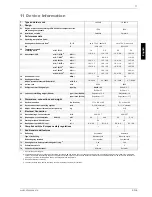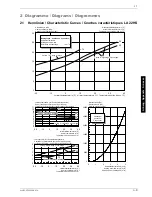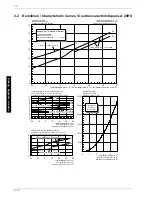
www.dimplex.de
EN-7
English
8.2
Any faults occurring during operation are also displayed on the
heat pump controller and can be corrected as described in the
operating instructions of the heat pump controller.
For external temperatures below 10 °C and heating water tem-
peratures below 16 °C, the buffer tank should be heated up with
the second heat generator to at least 25 °C.
Observe the following procedure to implement a smooth start-up:
1)
Close all of the heating circuits.
2)
Fully open the overflow valve.
3)
Use the controller to select the automatic operating mode.
4)
Wait until the buffer tank has reached a temperature of at
least 25 °C.
5)
Now slowly reopen the heating circuit valves in succession
so that the heating water throughput is constantly raised by
slightly opening the respective heating circuit. The heating
water temperature in the buffer tank must not be allowed to
drop below 20 °C during this process. This ensures that the
heat pump can be defrosted at any time.
6)
Set the minimum volume flow quantity on the overflow valve
and heat circulating pump when all heating circuits are fully
open and a heating water temperature in the buffer tank of
approx. 20 °C is maintained.
7)
New buildings have an increased heat consumption on ac-
count of the energy required to dry them out. This increased
heat consumption means that marginally dimensioned heat-
ing systems can not always achieve the desired room tem-
perature. In such cases, we recommend keeping a second
heat generator on standby during the first heating period.
The limit temperature on the heat pump controller should
also be turned up to 15 °C.
8 Maintenance / Cleaning
8.1 Maintenance
To protect the paintwork, avoid leaning anything against the de-
vice or putting objects on the device. External heat pump parts
can be wiped with a damp cloth and domestic cleaner.
ATTENTION!
Never use cleaning agents containing sand, soda, acid or chloride as
these can damage the surfaces.
To prevent faults due to sediment in the heat exchanger of the
heat pump, ensure that the heat exchanger in the heating system
can not be contaminated. In the event that operating malfunc-
tions due to contamination still occur, the system should be
cleaned as described below.
8.2 Cleaning the Heating System
The ingress of oxygen into the heating water circuit may result in
the formation of oxidation products (rust), particularly if steel
components are used. These products enter the heating system
via the valves, the circulating pumps and/or plastic pipes. It is
therefore essential - in particular with respect to the piping of un-
derfloor heating systems - that only diffusion-proof materials are
used.
ATTENTION!
We recommend the installation of a suitable corrosion protection system
to prevent the formation of deposits (e.g. rust) in the condenser of the
heat pump.
Residue from lubricants and sealants may also contaminate the
heating water.
In the case of severe contamination leading to a reduction in the
performance of the liquifier in the heat pump, the system must be
cleaned by a heating technician.
According to today’s state of knowledge, we recommend using a
5 % phosphoric acid solution for cleaning purposes. However, if
cleaning needs to be performed more frequently, a 5 % formic
acid solution should be used.
In either case, the cleaning fluid should be at room temperature.
We recommend flushing the heat exchanger in the direction op-
posite to the normal flow direction.
To prevent acidic cleaning agents from entering the heating sys-
tem circuit, we recommend connecting the flushing device di-
rectly to the flow and return flow of the liquifier of the heat pump.
It is important that the system be thoroughly flushed using appro-
priate neutralising agents to prevent any damage from being
caused by cleaning agent residue remaining in the system.
Acids must be used with great care and all relevant regulations of
the employers’ liability insurance associations must be adhered
to.
If in doubt, contact the manufacturer of the chemicals!
Heat source
temperature
Max. temperature spread
between heating flow and return
flow
From
To
-20 °C
-15 °C
4 K
-14 °C
-10 °C
5 K
-9 °C
-5 °C
6 K
-4 °C
0 °C
7 K
1 °C
5 °C
8 K
6 °C
10 °C
9 K
11 °C
15 °C
10 K
16 °C
20 °C
11 K
21 °C
25 °C
12 K
26 °C
30 °C
13 K
31 °C
35 °C
14 K
Summary of Contents for LA 22HS
Page 2: ......




